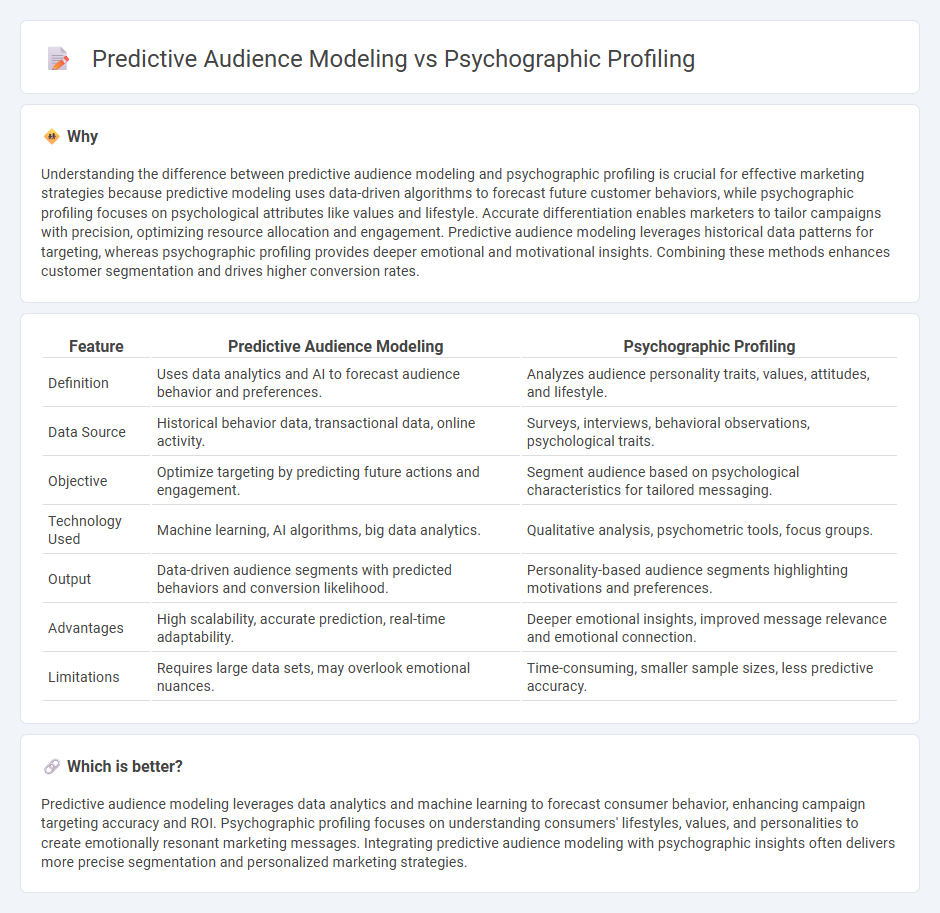
Predictive audience modeling leverages data analytics and machine learning algorithms to forecast consumer behaviors and segment audiences based on past interactions and demographic information. Psychographic profiling focuses on understanding audience values, attitudes, interests, and lifestyle choices to create more personalized marketing messages. Explore the differences in these approaches to optimize your marketing strategy.
Why it is important
Understanding the difference between predictive audience modeling and psychographic profiling is crucial for effective marketing strategies because predictive modeling uses data-driven algorithms to forecast future customer behaviors, while psychographic profiling focuses on psychological attributes like values and lifestyle. Accurate differentiation enables marketers to tailor campaigns with precision, optimizing resource allocation and engagement. Predictive audience modeling leverages historical data patterns for targeting, whereas psychographic profiling provides deeper emotional and motivational insights. Combining these methods enhances customer segmentation and drives higher conversion rates.
Comparison Table
| Feature | Predictive Audience Modeling | Psychographic Profiling |
|---|---|---|
| Definition | Uses data analytics and AI to forecast audience behavior and preferences. | Analyzes audience personality traits, values, attitudes, and lifestyle. |
| Data Source | Historical behavior data, transactional data, online activity. | Surveys, interviews, behavioral observations, psychological traits. |
| Objective | Optimize targeting by predicting future actions and engagement. | Segment audience based on psychological characteristics for tailored messaging. |
| Technology Used | Machine learning, AI algorithms, big data analytics. | Qualitative analysis, psychometric tools, focus groups. |
| Output | Data-driven audience segments with predicted behaviors and conversion likelihood. | Personality-based audience segments highlighting motivations and preferences. |
| Advantages | High scalability, accurate prediction, real-time adaptability. | Deeper emotional insights, improved message relevance and emotional connection. |
| Limitations | Requires large data sets, may overlook emotional nuances. | Time-consuming, smaller sample sizes, less predictive accuracy. |
Which is better?
Predictive audience modeling leverages data analytics and machine learning to forecast consumer behavior, enhancing campaign targeting accuracy and ROI. Psychographic profiling focuses on understanding consumers' lifestyles, values, and personalities to create emotionally resonant marketing messages. Integrating predictive audience modeling with psychographic insights often delivers more precise segmentation and personalized marketing strategies.
Connection
Predictive audience modeling leverages psychographic profiling to analyze consumer attitudes, values, and lifestyles, enabling marketers to forecast future behaviors with higher accuracy. Integrating psychographic data into predictive models enhances targeting strategies by identifying nuanced audience segments based on personality traits and motivations. This connection drives more personalized marketing campaigns that improve engagement and conversion rates.
Key Terms
**Psychographic Profiling:**
Psychographic profiling analyzes consumers' values, attitudes, interests, and lifestyles to create detailed personas that help businesses tailor marketing strategies effectively. This approach leverages data from surveys, social media activity, and behavioral insights to predict motivations and purchasing decisions. Discover how psychographic profiling can enhance your audience understanding and improve campaign performance.
Lifestyle
Psychographic profiling analyzes individuals' lifestyles by examining values, interests, and personality traits to create detailed audience segments. Predictive audience modeling uses statistical algorithms to forecast future behaviors based on past interactions within similar lifestyle groups. Explore deeper insights into how these methodologies enhance targeted marketing strategies.
Values
Psychographic profiling emphasizes understanding audience values, beliefs, and lifestyles to create detailed customer personas, enhancing targeted marketing strategies. Predictive audience modeling uses data analytics and machine learning to forecast consumer behavior and segment audiences based on these predictions. Explore how integrating values into predictive models can elevate campaign precision and ROI.
Source and External Links
Psychographic profiling -- a method for developing relatable ... - Psychographic profiling is a segmentation method for identifying target audiences by analyzing attitudes, values, and lifestyles that go beyond traditional demographic boundaries.
Psychographics - Wikipedia - Psychographic profiling uses cognitive attributes like attitudes, interests, opinions, beliefs, and behaviors to create a detailed mental and behavioral profile of a person or group for marketing and advertising purposes.
What Are Psychographics & How Are They Used in Marketing? - Psychographic profiling aggregates data on activities, interests, and opinions (AIO), including personality traits, lifestyle choices, and values, to understand and predict consumer motivations and behaviors.
 dowidth.com
dowidth.com